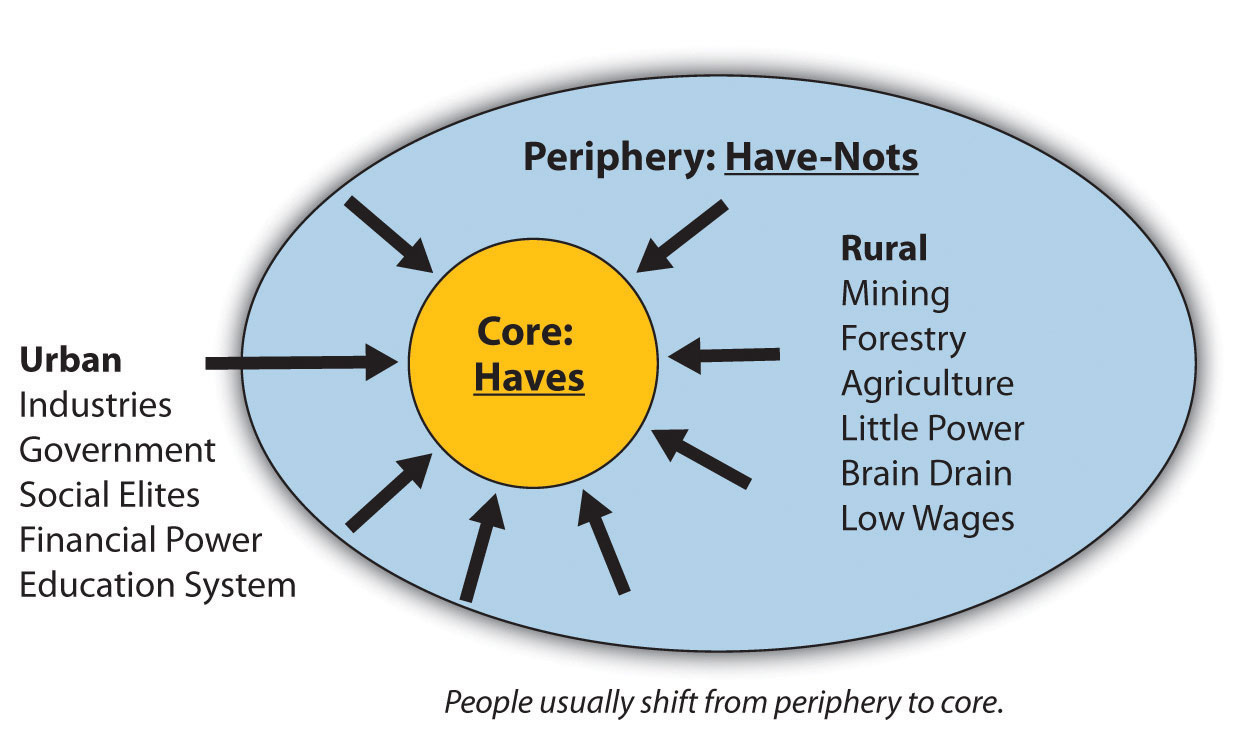Core-Periphery Model is a model of the spatial organization of human activity based upon the unequal distribution of power in economy and society.
The core dominates (although it in turn may be dominated from outside) whilst the periphery is dependent. This dependence is structured through the relations of exchange between core and periphery.
Unequal exchange, the concentration of economic power, technical progress and productive activity at the core, and the emanation of productive innovations from the core help to maintain the flow of surplus value (see Marxian economics) from core to periphery.
ADVERTISEMENTS:
For example, increases in productivity in the core may, with an effective labour movement, be translated into higher wages.
At the same time, a more plentiful supply of unorganized labour in the periphery may serve to sustain a downward pressure on wages.
If wage levels are reflected in the relative prices of the products exchanged between core and periphery, the consequence of higher wages in the core will either be to generate a balance of payments crisis in the periphery or to enforce increased exports from the periphery to finance the increased cost of imports.
ADVERTISEMENTS:
In either case autonomous development in the periphery is made more difficult and may, indeed, be subverted.
Such unequal relations may also be maintained by the implementation of economic and commercial policies favoring the core at the expense of the periphery (see colonialism, neocolonialism) and may be reinforced by migration and capital flows from periphery to core.
Core-periphery relations were seen by Friedman (1966), with whom the core-periphery model is most closely associated, as the second in a four-stage sequence of the development of the space economy.
The stages outlined by Friedman are: (a) pre-industrial society with localized economies; (b) core-periphery; (c) dispersion of economic activity and, to a lesser extent, control into certain parts of the periphery; and (d) the emergence of spatial integration in which the various and now more or less fully developed spatial parts of the economy relate in a more truly interdependent manner.
ADVERTISEMENTS:
Although it implies inter-regional conflict rather than equilibrium and so emphasizes the uneven nature of economic development, the core-periphery model has several deficiencies stemming, in the main, from its reliance upon exchange relations and the abstract nature of power in the model.
Thus, it is false to assume that the social concentration of power necessarily leads to spatial concentration and that the redistribution of power is somehow associated with development and the emergence of an integrated space economy.
Economic power stems from control over the means of production and derives its specific historical characteristics from the nature of this control.
The spatial arrangement and transformation of a capitalist economy at a particular point in time reflects, above all, the current requirements of accumulation and the historical legacy of a landscape created by previous rounds of accumulation.
Thus, a spatial redistribution of productive activity and the decentralization of decision-making over the productive process may generate what appears to be a more highly integrated form of spatial organization without in any way shifting power over the means of production from capital to labour.
Nor does it imply that the spatial location of control over the means of production has been decentralized. In fact, the concentration of control is more likely to be intensified rather than reduced as the economy becomes more highly integrated in spatial terms and is geographical development evolves in accordance with a development plan.
Thus, the second and third stages of Friedman’s model and the policies of regional development with which they may be associated would certainly lead to a less unequal exchange between core and periphery.
But they ought, more correctly, to be seen as a means whereby surplus may be extracted from the economy as a whole rather than as a means of diffusing development.
A more genuine redistribution of development would, necessarily, involve a fundamental transformation of the relations of control over the means of production.

